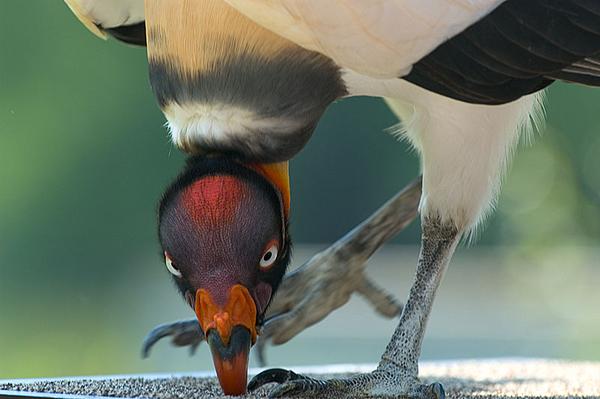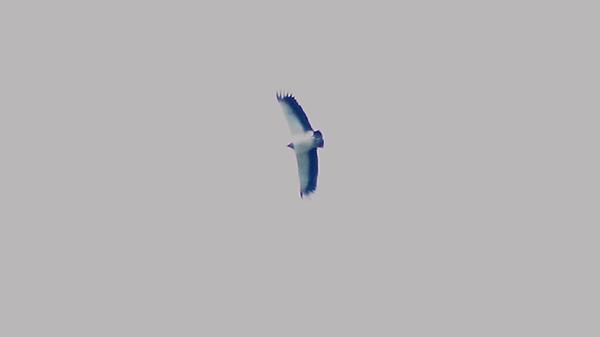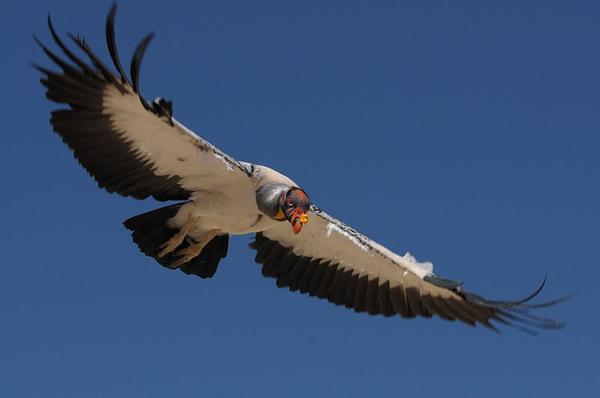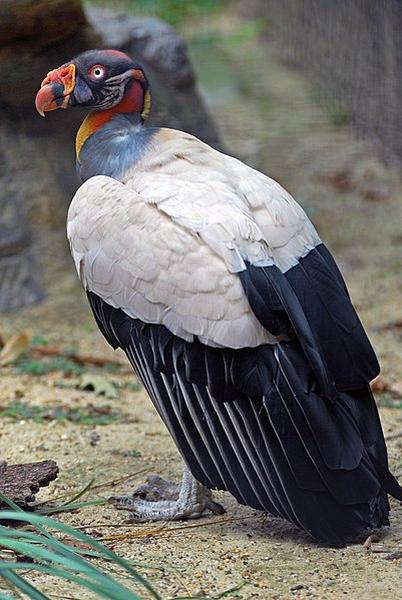
On a birding trip to Panama:
In the skies over Central and South America you may see The King soaring overhead.
As large as a bald eagle, the king vulture (Sarcoramphus papa) can weigh up to 10 pounds with a wingspan seven feet long.
From below he’s unmistakable — all white with black flight feathers, a black tail and a dot for his head. His head looks small because he’s bald.

If he came in for a landing you’d see that his bare skin is colorful — yellow, red and orange.

Though the king vulture (Sarcoramphus papa) is related to condors and our familiar turkey and black vultures, he’s the only surviving member of his genus. His last name, papa, is Latin for pope and was chosen because his white and black feathers resemble a pope’s vestments.

No matter his title, king or pope, the King is in charge at the dinner table. His powerful beak tears open carcasses. When he arrives on the scene other vultures move away.
Like royalty, the King eats first. When he’s finished everyone else can dine.
(photos from Wikimedia Commons; click on the images to see the originals)
Day 3: Pipeline Road on the border of the Soberania National Park
Wow, even the vultures are colorful there. Hope one soars your way and you are seeing lots of cool stuff!
Enjoy! I can’t wait to hear about the famous pipeline! Meanwhile, snow in Pittsburgh.
Hi Kate,
The close up picture of the vulture on the wing excellently shows both wing camber and winglet geometry. The camber provides the desired lift as the air glides over the wing and the winglet feathers at the wingtips reduce drag from drag inducing vortices.
Very cool, thanks for posting the pix and info,
Gene
Camber definition: In aeronautics and aeronautical engineering, camber is the asymmetry between the two acting surfaces of an aerofoil, with the top surface of a wing (or correspondingly the front surface of a propeller blade) commonly being more convex (positive camber).
The King Vulture is gorgeous! Much too beautiful to be a scavenger of carrion. Clad in a king’s raiment and deserving his place as the King.
Meanwhile, back in Pittsburgh, we have SNOW! More snow than there’s been all winter. A huge flock of Redwinged Blackbirds on their way north to establish nesting territories, have decided that my yard is the perfect place for a stopover. There must be a hundred of them pecking and scratching at the snow. I felt sorry for them, and also for the little sparrows and juncos that were being crowded out of the scrum. I went out and scattered a liberal amount of seed. I’m not worried about it getting covered up. The birds will have it eaten soon.
I also spread seed in front of the patio door. It provides entertainment for my cat and also a sheltered place for the little birds to feed. Now there are two big male turkeys that have discovered it as an excellent place. They come right up to the glass, and this being That Time of Year, put on a mating display. Always the same two, always together.
Hi Kate,
I’m sure you are having a great time. Vultures are amazing! I recently learned about the special bacteria they have in their guts to digest the rotting flesh they feed on. They also urinate on their legs and feet to clean them.
If there’s a “next life,” I think coming back as a vulture would have its perks. You spend most of your time soaring, you aren’t (usually) required to kill another living being in order to eat, you have a cast iron stomach and almost never get sick, and you have few natural enemies – except for the big one, people and their ignorance, refuse, poisons etc.
For a fascinating account of how researchers at Hawk Mountain Sanctuary in Kempton, Pennsylvania are studying vultures (new world and old world), I recommend following their ” Vulture Chronicles” blog: https://thevulturechronicles.wordpress.com/